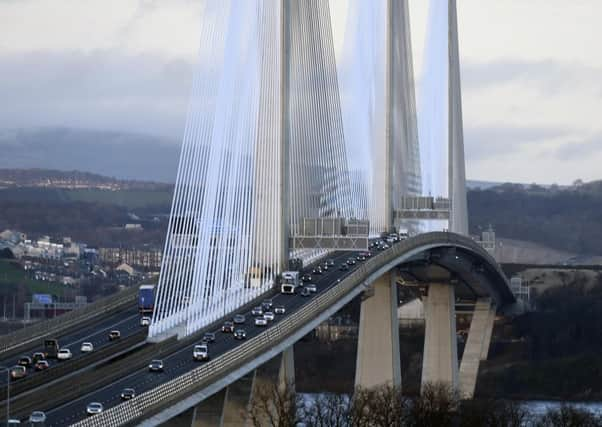Queensferry Crossing ‘has made journey times shorter’
This article contains affiliate links. We may earn a small commission on items purchased through this article, but that does not affect our editorial judgement.


The national authority also said that modern wind barriers across the Queensferry Crossing have kept it open on 34 occasions when its predecessor would have been closed to high-sided vehicles.
Newly published wind speed threshold data suggests the new structure has saved the economy and hauliers millions of pounds in fuel costs, diversions and missed appointments since opening in the summer of 2017.
Advertisement
Hide AdAdvertisement
Hide AdFurther data from separate pedestrian and cycle counters on the Forth Road Bridge, show over 186,000 pedestrians and cyclists have used the east and west footpaths across the FRB this past year alone.
Analysis shows that the crossing has, on average, reduced the journey time from M90 Junction 2 Admiralty, to the M90/M9 Junction by up to 5 minutes at peak times, compared to the same route using the FRB previously. The free-flow journey time remains as it was before, being a slightly longer route, but offering a higher speed limit.
Hard shoulders on the new bridge have also reduced delays resulting from accidents and breakdowns, according to Transport Scotland.
Advertisement
Hide AdAdvertisement
Hide AdAnalysis of journeys over both bridges has shown that the ability to respond and restore normal journey times has significantly improved. The typical duration of an incident on the QFC is around one hour from the start of an incident through to restoring normal traffic conditions. On the FRB the typical duration of an incident ranged from one hour to up to five hours.
Additional elements of the Intelligent Transport Systems (ITS) will take some time to bed in as motorists get used to the new features, however it’s hoped the Variable Mandatory Speed Limit (VMSL) system and Ramp Metering system will eventually bring operational benefits to the Forth corridor once fully optimised.
Cabinet Secretary for Transport, Connectivity and Infrastructure Michael Matheson said: “The primary benefit to road users is undoubtedly the increased resilience of the Queensferry Crossing. On over thirty occasions in the past two years when previously hauliers, businesses and the delivery chain would have been disrupted using the Forth Road Bridge, the Crossing has stayed open.
“When incidents do occur on the bridge, the availability of a hard-shoulder has often allowed ‘business as usual’ journey times to be restored much faster than previously seen. Of course there is always scope for improvement and the new features will take some time to bed in.
Advertisement
Hide AdAdvertisement
Hide Ad“The use of the FRB as a dedicated public transport corridor, and the associated bus lane infrastructure, has reduced journey times for public transport users from the Fife park and ride sites by around 40 per cent between Ferrytoll and Newbridge at peak times compared to the car. Freeing up the FRB to encourage more cycling and walking is also paying dividends.”
Martin Reid, Policy Director at the Road Haulage Association said: “There is little doubt that the Queensferry Crossing has been of huge benefit to the Scottish logistics sector and by extension, the whole Scottish economy.
“We have seen over the past few years that we are increasingly at the mercy of weather events, some of which have been without precedent. It did not take long for shelves to become empty during ‘The Beast from the East’ and businesses of all kinds have been affected by recent flooding events and storms.
“The fact that the Crossing has remained open 34 times in weather conditions that would have closed the Forth Road Bridge has allowed freight to keep moving and supplies arriving to those most vulnerable and to communities who are often isolated.
Advertisement
Hide AdAdvertisement
Hide Ad“It is well documented that road hauliers often work with very low margins and the cost of delay and detour can decimate much needed profit, so for our industry, keeping the arterial routes open are a must. We face uncertain times post Brexit and supply chains will undoubtedly come under pressure. It is therefore vital that the parts of the journey that are under our control remain smooth and fluid. The resilience of the Forth Crossing during high winds remains a vital factor in getting many time sensitive goods to market, both here in the UK and also the ports in the south for export”.
Mark Arndt, Account Director for Forth Bridges Operating Company Amey, said: “The Queensferry Crossing now provides a reliable route for cross-Forth motorway traffic, and this has allowed us to make good progress on major maintenance projects on the Forth Road Bridge at lower cost and without any of the severe disruption these works would have caused previously.
“The truss end links that caused so much disruption when they failed in 2015 have now been replaced by completely redesigned and improved components, and to replace the main expansion joints we’ve been able to close a carriageway on the bridge for nine months without causing any delays. Without the Queensferry Crossing available to carry traffic, the replacement of these joints would have caused severe disruption and economic impact over an extended period.”
Get in touch and tell us your story
Email: [email protected]
Twitter: @FFP
Facebook: www.facebook.com/FifeFreePress